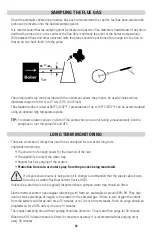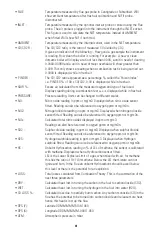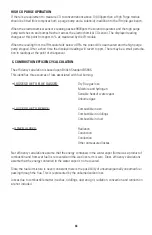
44
HIGH CO PURGE OPERATION
If there is a requirement to measure CO to concentrations above 10,000ppm then a High Purge module
should be fitted (this comprises both a purge pump and a solenoid) in addition to the IR triple gas bench.
When the electrochemical sensor’s reading passes 9800ppm the solenoid operates and the high purge
pump switches on and pumps fresh air across the electrochemical CO sensor. The displayed reading
changes at this point from ppm to % as measured by the IR module.
When the reading from the IR module falls below 0.95% the solenoid is deactivated and the high purge
pump stopped. After a short time the displayed reading will revert to ppm. There may be a small perturba-
tion in readings at the point of changeover.
C. COMBUSTION EFFICIENCY CALCULATION
The efficiency calculation is based upon British Standard BS845.
This identifies three sources of loss associated with fuel burning:
•
LOSSES DUE TO FLUE GASSES:
Dry Flue gas loss,
Moisture and hydrogen
Sensible heat of water vapor
Unburned gas
•
LOSSES DUE TO REFUSE:
Combustible in ash
Combustible in riddlings
Combustible in dust
•
OTHER LOSSES:
Radiation
Convection
Conduction
Other unmeasured losses
Net efficiency calculations assume that the energy contained in the water vapor (formed as a product of
combustion and from wet fuel) is recovered and the wet loss term is zero. Gross efficiency calculations
assume that the energy contained in the water vapor is not recovered.
Since the fuel air mixture is never consistent there is the possibility of unburned/partially unburned fuel
passing through the flue. This is represented by the unburned carbon loss.
Losses due to combustible matter in ashes, riddlings, dust and grit, radiation, convection and conduction
are not included.
Summary of Contents for K9206
Page 29: ...29 ...



















